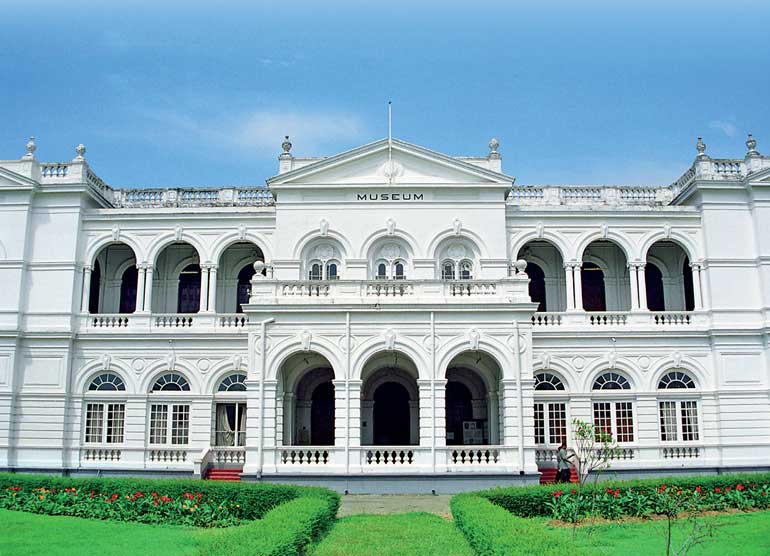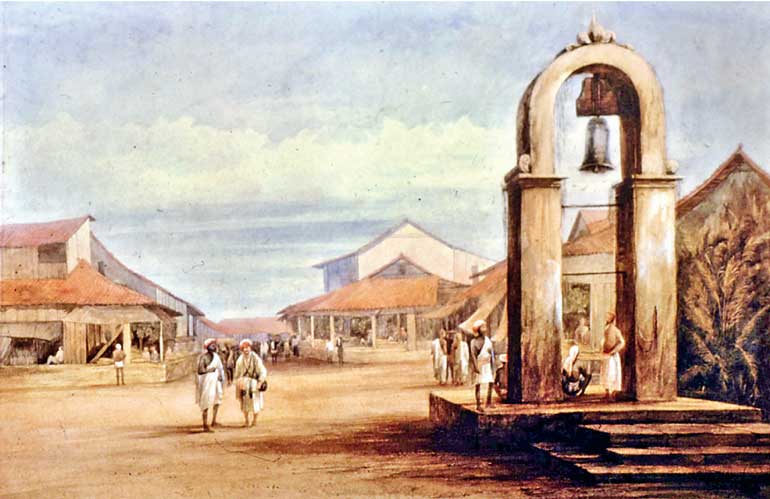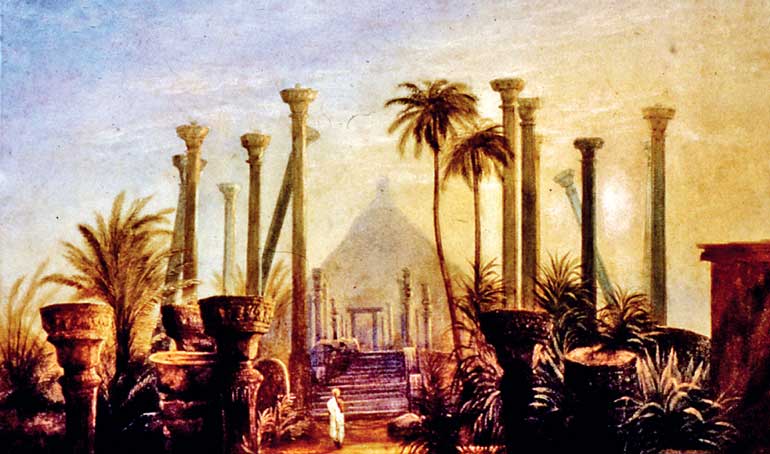Saturday Dec 13, 2025
Saturday Dec 13, 2025
Saturday, 14 January 2023 00:10 - - {{hitsCtrl.values.hits}}
 Colombo National Museum - repository of Nicholl's impressions of the island
Colombo National Museum - repository of Nicholl's impressions of the island
 By Randima Attygalle
By Randima Attygalle
Colombo Museum’s ongoing temporary exhibition (held until 20 Jan.) featuring a rare collection of books, ola leaves, stamps, paintings and manuscripts, enables a window to the work of the Irish watercolourist Andrew Nicholl who was in then Ceylon from 1846 to 1849. The exhibition which features two of his notable water colour paintings of Lankathilakaya and Thuparamaya urges the art lover to take ‘A Tour of the Island’ (the banner under which they are exhibited) with the renowned artist in the Painting Gallery of the Colombo Museum. The water colours depicting fauna, flora and sights of the island which Nicholl captured during a tour of the island with the Colonial Secretary, Sir James Emerson Tennent, transport a viewer to a pastoral existence.
Colombo Academy days
Son of a shoemaker Andrew Nicholl was born in Belfast on 4 April 1804. Nicholl made his reputation as a landscape painter in Belfast in his early twenties. In about 1830 he went to London and to Dublin in 1832 where he executed topographical work, many of which were engraved. In 1837 he was elected as Associate of the Royal Hibernian Academy. In 1840 Nicholl returned to London where he made a career out of teaching.
In 1846 when a teaching vacancy was advertised on behalf of the Colombo Academy (present Royal College), Nicholl arrived on the island to take up the post to teach landscape drawing, painting, scientific drawing and design there. Interestingly, the Principal of the Academy, then located at Messenger Street in Pettah, was Dr. Barcroft Boake, an Irishman himself.
Nicholl eventually became a friend of Sir James Emerson Tennent who was the Colonial Secretary of Ceylon at that time. Prof. Albert Dharmasiri in his paper, ‘Paintings: Modern Period (1815-1950)’ published in the Archaeological Department Centenary Commemorative Series (Vol. 5 edited by Prof. Nandadeva Wijesekera) notes that, Sir James Emerson Tennent was ‘Nicholl’s patron and friend’.
Sketching tour of the island
In 1848 Nicholl toured through the interior of Ceylon with Tennent. An account of this tour was published in the ‘Dublin University Magazine’ in 1852 under the heading ‘A Sketching tour of Five Weeks in the Forests of Ceylon, its ruined temples, colossal statues, tanks, dagobahs’. In it he describes in detail the vegetation of the countryside, conveying his enthusiasm for the subject. (Source: Painting Gallery literature of Colombo Museum) Although the tour was not without its difficulties and hardships, Nicholl wrote: “Thus terminated my sketching tour through the forests of Ceylon, the most interesting I ever had in my life; and although attended with both danger and fatigue, yet the enjoyment which I derived from it far more than compensated for the hardship of my sketching excursions, either at home or in distant lands.” Nicholl also contributed 31 wood engravings to Tennent’s book ‘Ceylon’.
Nicholl died in London on 16 April, 1886. He was 82 then. In May the same year, his brother William Nicholl held an exhibition of the artist’s work in Belfast. Among the works exhibited were 41 watercolours listed under the heading ‘Studies of Plants of Ceylon.’
Capturing strange and exotic lands
Topographical artists such as Nicholl, were accompanied by the British colonial administrators and explorers to record scenes and localities of the countries they visited or conquered, notes Prof. Dharmasiri in his writing. “The purpose was to keep the British public informed of their activities. Most of those water colours were converted to engravings in England; they were published as illustrations in books or as editions or individual prints. The lack of sufficient patronage and poor financial prospects of the landscape painters was another factor which led them to seek their fortunes in exotic tropical colonies under British occupation. The representation of picturesque subjects and antiquarian remains of those strange lands made an impact on the coeval spirit of antiquarianism and connoisseurship of the British elite,” documents the scholar.

Kayman's Gate
Thuparamaya
Conservation
According to the National Museum Colombo’s Guide, the water colour collection of Nicholl’s was first displayed there in 1949 in connection with the first anniversary celebrations of independence. The exhibition was collaborated by the British Museum. The paintings, according to Museum sources, were gifted to the Colombo National Museum by eminent historian and the then Director of the National Museum, Dr. P.E.P. Deraniyagala.
Among the 28 magnificent watercolours of Nicholl which were donated, are Lankathilakaya Polonnaruwa, Stone steps of Mihintale, Ramboda falls Monaragala, Minneriya tank, Lotuses in Colombo Lake, Mutwal, Colombo, Colombo from Mutwal, Colombo, Galle, Dambulla Viharaya entrance, Watadeage, Polonnaruwa, Kayman’s Gate Pettah and Banyan tree in Mount Lavinia.
The watercolour paintings of Ceylon as seen by Nicholl during his stay in the island were badly soiled due to long exposure to light and were conserved by a team of expert conservators from the British Museum once they arrived there on 7 October 1997. The most up-to-date washing methods then available at the British Museum were used for the conservation process. Ultrasonic mist and a barrier material with micro pores were used for humidification with filtered water according to the Museum literature displayed in the Gallery.
An air brush or pressurised canister was then used for selective spraying and the spread of moisture was controlled by a suction table. Discolouration and degraded products were thus very slowly released from the paper and drawn out into blotting paper without affecting moisture sensitive colours. Local bleaching was used to remove uneven discolouration mould and foxing marks. Once the bleaching residues were removed by washing, the paintings were lightly sized and damaged areas were retouched before mounting for display.
Bringing heritage closer
After the arrival of the conserved paintings at the Colombo Museum in 1998, a special exhibition was held at the Colombo Museum in line with Sri Lanka’s 50 years independence celebrations before they were permanently displayed in the gallery dedicated to the artist.
The present Director General of the Department of National Museums, Sanuja Kasthuriarachchi who was then a new face at the Colombo National Museum recollects the special exhibition. “The exhibition was open to the public for nearly a year and when I joined the Department in 1999 as the Deputy Director (Anthropology) I remember the special exhibition of Andrew Nicholl paintings taking place.” Commenting about the ongoing temporary exhibition of a rare collection of objects among which are a few of Nicholl’s paintings, Kasthuriarachchi says: “Temporary exhibitions enable visitors to enjoy certain objects which are deposited in the museum collections but are not often exhibited in public galleries. Some of these interesting objects encourage history lovers and researchers to take up further research and reading on them. We also invite corporates and other well-wishers to come forward to collaborate with us and assist us to host more of these exhibitions with the aim of bringing heritage closer to the public.”
Pic credit: Colombo
National Museum